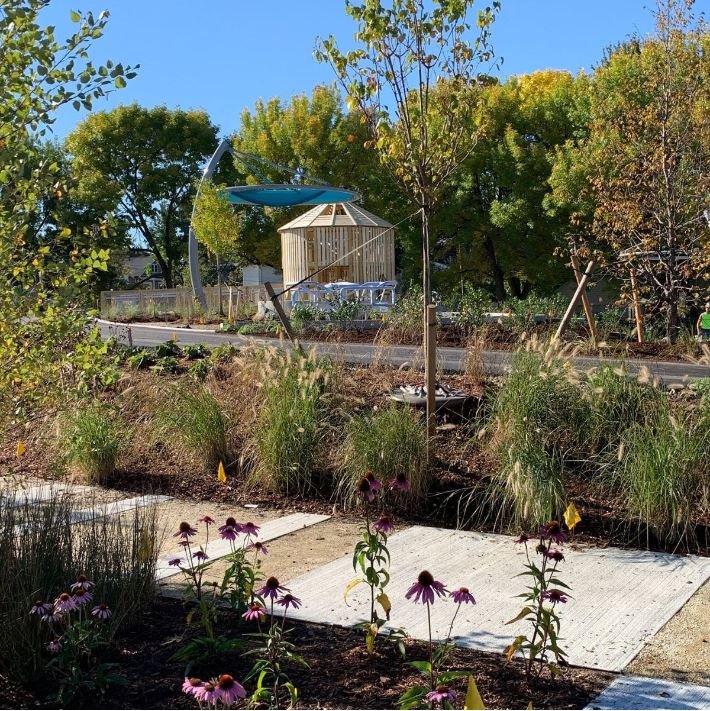Civic Design
A Playground Designed with Everyone in Mind
This past November, hundreds turned out on a brisk Saturday to celebrate the opening of the City of Cambridge Universal Design Playground. Located in Danehy Park in West Cambridge, the $5.8 million playground stretches across a 30,000 square foot area. The site is on top of a landfill, formerly an early 1900s clay pit run by the New England Brick Company.
Following a feasibility study conducted in 2018, the city selected the firm Weston & Sampson, a design/civil engineering firm committed to the principles of inclusion, diversity, equity, and access (IDEA) to lead the design and engineering of the playground. For a year and a half, the firm worked closely with focus groups of diverse community residents and took inspiration from the universal design of Mayor Thomas M. Menino Park in Charlestown.
The playground is the first in the city to fully incorporate universal design, which is, “the design and composition of an environment so that it can be accessed, understood and used to the greatest extent possible by all people regardless of their age, size, ability or disability.” According to Section 508 of the U.S. General Services Administration (GSA) universal design is based on 7 principles:
Equitable Use - The design is useful and marketable to people with diverse abilities.
Flexibility In Use - The design accommodates a wide range of individual preferences and abilities.
Simple And Intuitive Use - Use of the design is easy to understand, regardless of the user’s experience, knowledge, language skills, or current concentration level.
Perceptible Information - The design communicates necessary information effectively to the user, regardless of the ambient conditions or the user’s sensory abilities.
Tolerance For Error - The design minimizes hazards and the adverse consequences of accidental or unintended actions.
Low Physical Effort - The design can be used efficiently and comfortably and with a minimum of fatigue.
Size And Space For Approach And Use - Appropriate size and space is provided for approach, reach, manipulation, and use regardless of user’s body size, posture, or mobility.
With roughly 1 in 8 people in the US known to have a disability, there is a huge incentive for the government and businesses alike to invest in accessible, inclusive designs that are available to all users.
The play equipment, landscaping, and layout at the Cambridge project are inspired by the site's industrial past. Working with the existing landform, designers created a play experience that benefits users physically and developmentally. However, the playground design considers not only the mobile accessibility of its users, but their sensory, cognitive, and emotional abilities as well. Along with accessible play areas for children and seniors, the park includes a splash pad and a sensory walk zone. The walk zone, which features a pathway designed with bands of crushed stone, concrete, and granite pavers, provides users with a tactile and auditory experience from the changing textures, whether or not they use a mobility device.
A unique feature of the playground design is the city’s collaboration with local artists. One such collaboration is “Sensory Hilltop”, created by Cambridge artist Mitch Ryerson, who designs naturalized play experiences that integrate into their surroundings. Sensory Hilltop is located on a naturally sloped area and reached through an accessible labyrinth-style pathway. The hilltop features a sensory/nature play area that includes log steppers, a log climber, and a central wooden structure. Visitors can explore making sounds with the wooden marimba and benches featuring animal-shaped engravings provide a tactile experience. Ryerson used repurposed Black Locust wood, known for its resistance to rot and splinters from trees near Cambridge’s Fresh Pond to construct the elements.
Another artistic collaboration is the art-play sculpture, Pipedreams, designed by students at NuVu Studio in Central Square. An innovative school for middle and high school students, NuVu focuses on developing a variety of design skills. The tunnel-shaped installation celebrates the industrial legacy of Danehy Park. Along with window features and handholds that invite climbing, the smooth, curved wood planks create a sensory experience for all visitors.
The opening of the Universal Design playground has ensured that anyone at any age - even those with sensory needs or physical disabilities - has a safe and welcoming place to play and explore.
Interested in reading more about all the features the Universal playground has to offer?
Check out this article.
To learn more about the unique design concept, process and individual components of the playground check out this PDF presentation.







